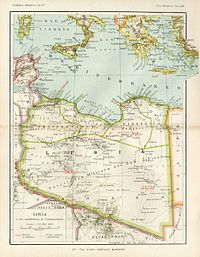Italian language in Libya
| Italian language in Libya | |
|---|---|
| Native to | Libya |
| Region | Tripolitania |
| Extinct | XX century |
| |
| Language codes | |
| ISO 639-3 | – |
The Italian language in Libya is related to the use of the Italian in Libya and the influence of Italian loanwords in the Tripolitania Arab dialect.
History[edit]
Since the Middle Ages the Libyan Arabic has received influences from the Italian thanks to the Lingua Franca Mediterranea. But after the 1911 conquest of Libya by the Kingdom of Italy the influence of Italian has increased. Actually there are 682 loanwords in the dialect spoken in Tripolitania, according to Saul Hoffman[1]
The nearly seven hundred loanwords are related to many terms of Italian origin about mechanics, especially in reference to cars and workshop work, but without excluding carpentry, building, plumbing and everything related to electricity. There follow areas such as clothing and medicine and then food and drink and so on up to daily domestic terms.
Under the colonial regime, Italian was the language of instruction in schools, but only a scattering of Muslim children attended these institutions. As a consequence, the Italian language did not take root in Libya to the extent that French did elsewhere in North Africa. Nevertheless, the strong wave of nationalism accompanying the 1969 revolution found expression in a campaign designed to elevate the status of the Arabic language. An order was issued requiring that all street signs, shop window notices, signboards, and traffic tickets be written in Arabic. This element of Arabization reached its apogee in 1973, when a decree was passed requiring that passports of persons seeking to enter the country contain the regular personal information in Arabic, a requirement that was strictly enforced. U.S. Library of Congress: Libya
The Italian language was spoken & fully understood by half the Arab native population of Italian Libya in 1940, according to historian P. Tripodi.
Some academics think that there was a kind of pidgin in Libya at the end of WW2: the Italian pidgin of Libya, spoken by the Italian colonists mainly in Tripoli and Benghazi. But with the disappearance of the Italians of Libya under Gheddafi this pidgin is no more in existence since the 1980s.
Italian loanwords (examples)[edit]
Italian loanwords exist mainly, but not exclusively, as a technical jargon. For example, machinery parts, workshop tools, electrical supplies, names of fish species, etc.
| Libyan Arabic | Italian | ||||
|---|---|---|---|---|---|
| Word | IPA | Meaning | Word | Meaning | |
| ṣālīṭa | sˤɑːliːtˤa | slope | salita | up slope | |
| kinšēllu | kənʃeːlːu | metallic gate | cancello | gate | |
| anglu | aŋɡuli | corner | angolo | corner | |
| ṭānṭa, uṭānṭa | tˤɑːntˤɑ, utˤɑːntˤɑ | truck | ottanta | eighty (a model of a truck of Italian make) | |
| tēsta | teːsta | a head butt | testa | head | |
Notes[edit]
- ↑ Saul Hoffman."IL LASCITO LINGUISTICO ITALIANO IN DODECANESO, LIBIA E CORNO D’AFRICA: L2, PIDGIN E PRESTITI". University Of Pavia. Pavia, 2013
Bibliography[edit]
- Hoffman, Saul. Il lascito linguistico italiano in Libia. L2, Pidgin e Prestiti. Libya; p. 40-64. University Of Pavia. Pavia, 2013 ([1])
- Metz Chopin, Hellen. Libya: A Country Study. Washington: GPO for the "Library of Congress". Washington, 1987.
- Tripodi, Paolo. The Colonial Legacy in Somalia (and in the Italian Empire). St. Martin's P Inc. New York, 1999.
See also[edit]
This article "Italian language in Libya" is from Wikipedia. The list of its authors can be seen in its historical and/or the page Edithistory:Italian language in Libya. Articles copied from Draft Namespace on Wikipedia could be seen on the Draft Namespace of Wikipedia and not main one.

